Contents
- History
- Trade & Ancient Trade Routes
- Modes of Transportation in the District
- Railway Systems
- Tram Systems
- Overview of Bus Networks
- Autos & Shared Vehicles
- Air Travel
- Ferries & Water Transport
- Traffic Map
- Communication Networks
- Newspapers & Magazines
- Graphs
- Road Safety and Violations
- A. Cases of Road Safety Violations
- B. Fines Collected from Road Safety Violations
- C. Vehicles involved in Road Accidents
- D. Age Groups of People Involved in Road Accidents
- E. Reported Road Accidents
- F. Type of Road Accidents
- G. Reported Injuries and Fatalities due to Road Accidents
- H. Injuries and Deaths by Type of Road
- I. Reported Road Accidents by Month
- J. Injuries and Deaths from Road Accidents (Time of Day)
- Transport Infrastructure
- A. Household Access to Transportation Assets
- B. Length of Roads
- C. Material of Roads
- Bus Transport
- A. Number of Buses
- B. Number of Bus Routes
- C. Length of Bus Routes
- D. Average Length of Bus Routes
- E. Daily Average Number of Passengers on Buses
- F. Revenue from Transportation
- G. Average Earnings per Passenger
- Communication and Media
- A. Household Access to Communication Assets
- B. Newspaper and Magazines Published
- C. Composition of Publication Frequencies
- Sources
NASHIK
Transport & Communication
Last updated on 6 November 2025. Help us improve the information on this page by clicking on suggest edits or writing to us.
History
Trade & Ancient Trade Routes
Nashik district occupies a significant position in the economic history of the Deccan due to its location and early connections to major inland trade routes. Historical references indicate that Nashik developed as a centre for textile production. Aditi Shah (2019) in her article writes that “Interestingly, many European historians believe that the style of silk and gold brocade that Marco Polo encountered in Baghdad in 1290 and called ‘nasich’ and ‘nac’ originally came from Nashik.” This suggests that the district may have contributed to the supply of fine textiles that travelled westward through established routes.
Nashik’s position along inland trade lines was important for its early prosperity. Shah (2019) writes that, “the secret to Nashik’s prosperity was that it lay on the trade route from Paithan in Maharashtra to Bharuch in Gujarat.” The district’s location on the line linking Tagara (modern Ter, Dharashiv) and Pratishthana (Paithan, Samhaji Nagar) with Bharuch (Gujarat) supports this connection, as merchants moving goods between the Deccan and western ports likely passed through the area. It is important to note that many scholars assert that Buddhist caves of this type were often situated along trade routes, serving both as rest stops and monasteries for traders and monks.

Early movement of goods would likely have relied on footpaths and pack animals. Over time, such routes supported local trade and transport. In later periods, roads and bus routes developed to link Nashik with nearby towns and markets, and the district continues to serve as a local trading centre.
Modes of Transportation in the District
Railway Systems
Nashik district falls under the Central Railway zone of Indian Railways and is part of the Bhusawal Division. The district’s main station is Nashik Road, which lies on the busy Mumbai–Bhusawal main line, an important section of the Mumbai–Howrah and Mumbai–Delhi trunk routes. Manmad Junction, another major station in the district, is a key railhead where multiple routes intersect, making it one of the busiest junctions in northern Maharashtra.
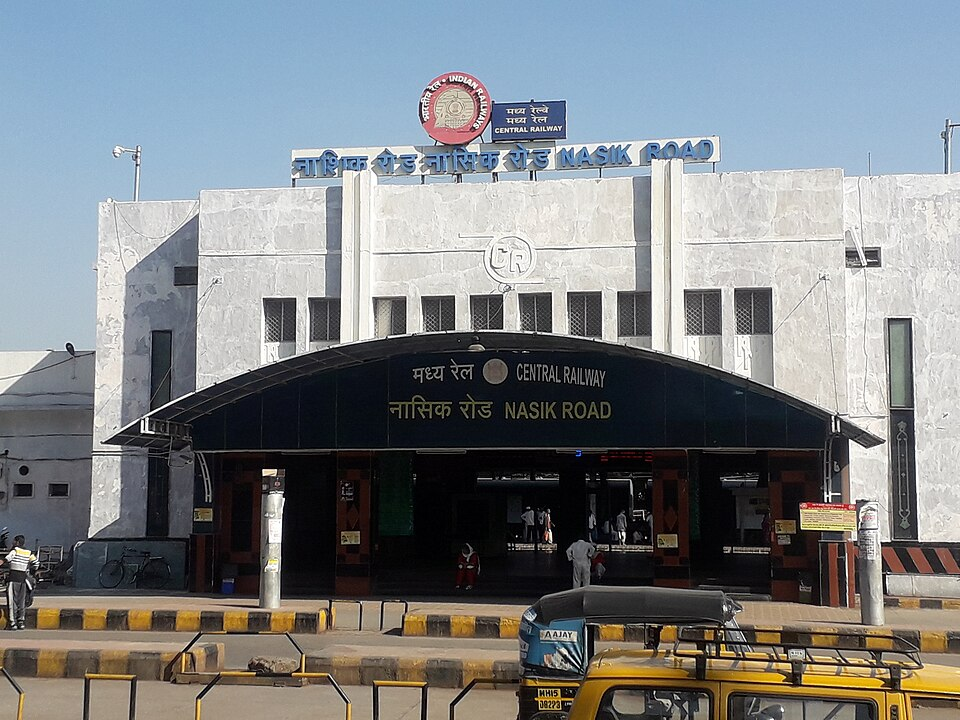
The district’s railway history dates to the mid-19th century. The Great Indian Peninsula Railway (GIPR) extended its line through Nashik in 1861, linking Mumbai with the Deccan. This route formed part of the Mumbai–Kolkata and Mumbai–Delhi corridors, carrying both passengers and goods from the port city to inland centres. The Dhond–Manmad State Railway, opened in 1878, connected Manmad southwards to Daund in Pune district, creating an additional north–south line that improved links between the northern Deccan, Pune, and further to Hyderabad.
The colonial district Gazetteer (1883) records that by the late 19th century, about 177 km of railway ran through the district and it had eleven stations, such as Igatpuri, Ghoti, Nashik Road, and Manmad. Construction for this began in 1857, and the Igatpuri–Nashik section opened in 1861. Notably, Igatpuri, located in the Western Ghats, served as an important ghat section station for trains climbing or descending between Mumbai and the Deccan plateau.
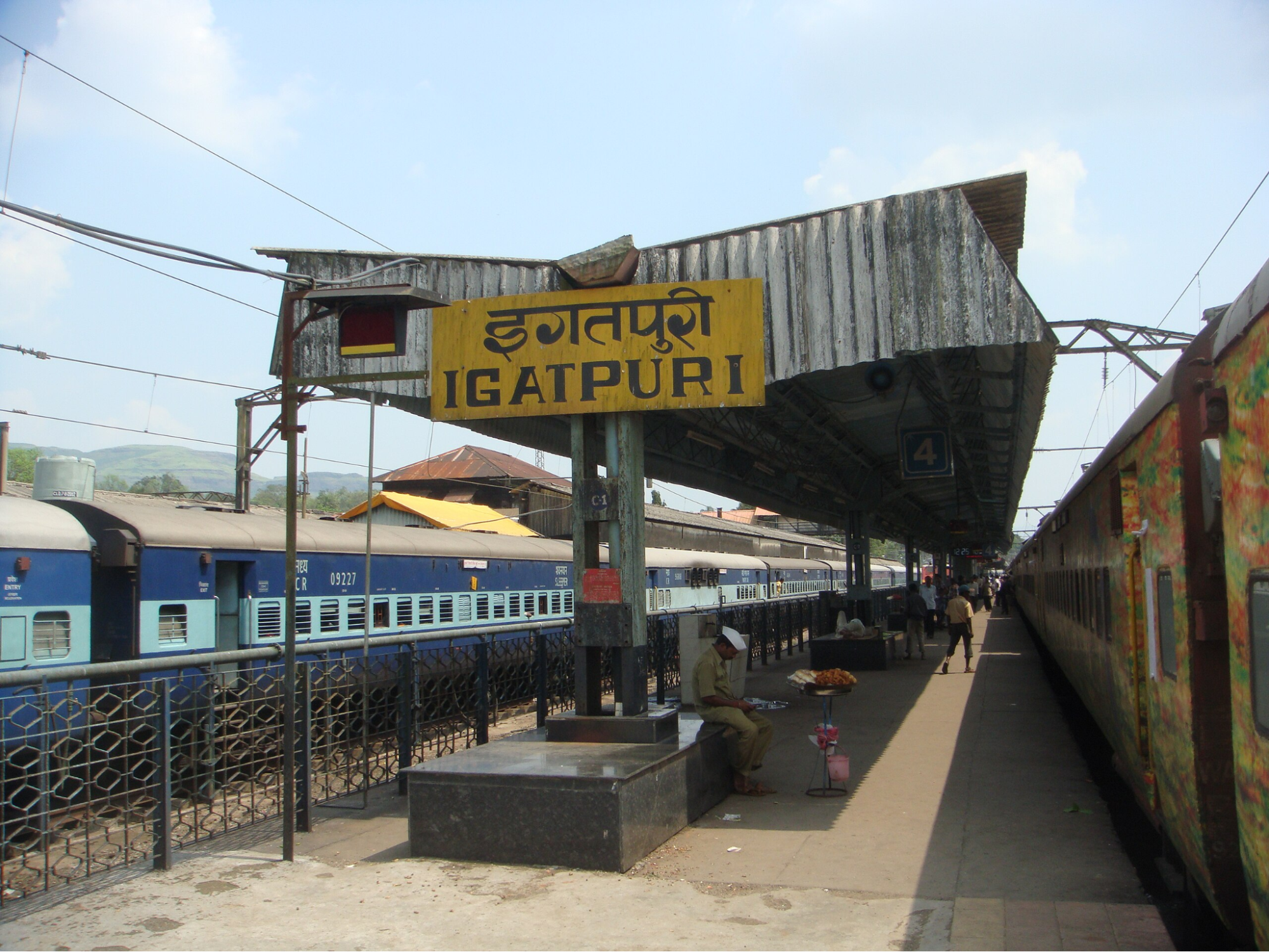
Today, the district’s main rail routes are:
- The Mumbai–Bhusawal–Itarsi line, carrying long-distance passenger trains to central, eastern, and northern India.
- The Secunderabad–Manmad line connects Secunderabad (Hyderabad) in Telangana to Manmad Junction in Nashik district.
- The Manmad–Daund line, providing north–south access between northern Maharashtra and Pune.
- Branch lines from Manmad connecting to Sambhaji Nagar and further east.
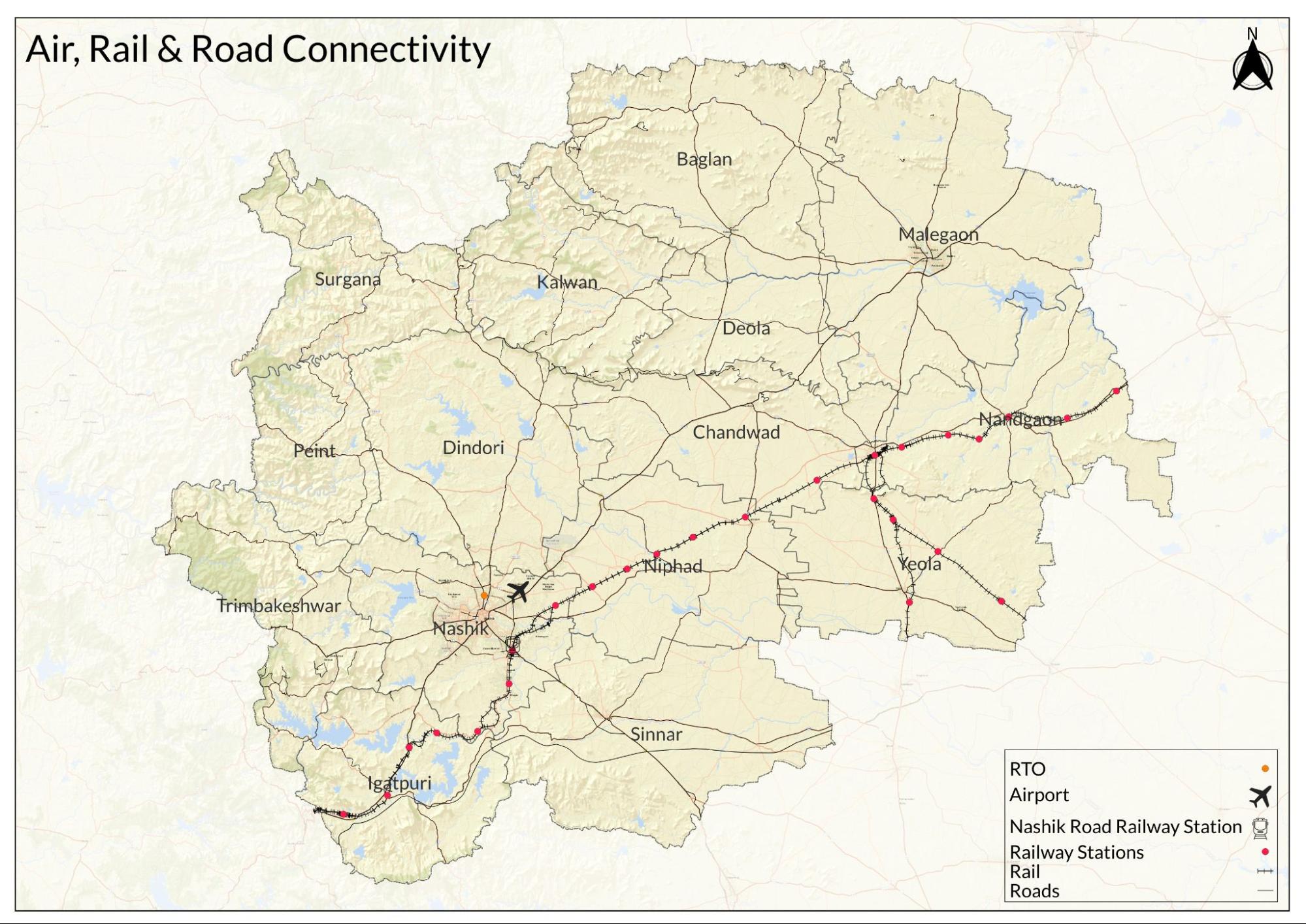
As mentioned above, Nashik Road station and Manmad Junction in the district are significant centers and handle significant freight traffic, including agricultural produce, industrial goods, and petroleum products. Both stations remain important stops for long-distance express trains and daily commuter services linking the district to Mumbai, Pune, Gujarat, Madhya Pradesh, and other states.
Plans have been proposed for a metro rail project in Nashik city and a multi-modal transport hub near Nashik Road station, intended to integrate local rail, bus, and other transport services to handle growing passenger demand.
Tram Systems
In the late 19th century, Nashik’s transport network began to expand with the arrival of the railway and the introduction of a local tramway. As mentioned above, the railway line through Nashik opened in 1861, connecting the district to Mumbai and the wider region. A few decades later, in 1889, a horse-drawn tram service was established to link the town more directly to Nashik Road railway station.
The tram line ran from the old Municipal Corporation building on Main Road to the railway station, covering about 8–10 km. It passed through local landmarks such as Bhadrakali Market and Ghasbazar, with parts of the route crossing lightly forested areas. The tram provided an affordable connection for passengers travelling between residential areas and the railway, with fares fixed at one paisa. Notably, earlier horse-drawn trams linked neighbourhoods to the main rail line and daily commuters.
In the early 1930s, the horse-drawn trams were replaced by petrol-powered vehicles. According to an article in Deshdoot (2021), this made Nashik the first city in India to operate petrol-driven trams. However, the system was phased out soon after as new forms of transport were introduced.
The trams ran for about 44 years before being discontinued. The original tram terminus on Main Road is now the site of the Municipal Corporation building, constructed in 1936, marking the shift to newer urban infrastructure. Though long discontinued, Nashik’s tram network remains part of the district’s early modern transport history.
Overview of Bus Networks
Bus services today form a crucial part of daily life in Nashik, providing residents with affordable and reliable connections within the city and to nearby towns and villages. The Maharashtra State Road Transport Corporation (MSRTC) continues to operate intercity and rural services across the district.
For local commuting within the city, the Citylinc bus system provides scheduled routes on urban roads and offers daily and monthly passes to make travel more convenient for residents. Operated by the Nashik Municipal Corporation (NMC), Citylinc officially began its city bus operations on 8 July 2021, beginning with 27 buses across 11 routes.
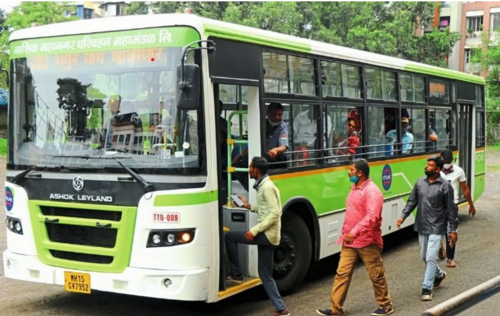
Currently, according to a report in the Times of India (2025), the civic body operates about 250 city buses on 60 routes across Nashik. According to NMC data cited in the same report, daily passenger footfall has increased to around 70,000, with daily income reaching ₹21 lakh over four years. Many commuters now use the bus system regularly instead of personal vehicles, and the number of students using concessionary bus passes has also grown.
The Citylinc initiative is part of broader efforts to modernise Nashik’s urban transport. The system has received recognition, including an Award for Excellence in Urban Transport (2021), for improvements in service delivery and user access. Passengers can check route details, fares, and passes online, which has helped streamline travel planning for daily users.
Despite these developments, there have been reports of labor disputes concerning delayed wages and working conditions for contractual staff. In some outlying areas, poor road conditions and limited terminal facilities continue to affect access. Addressing these issues remains important as Nashik’s population grows and demand for reliable transport increases.
Autos & Shared Vehicles
Auto-rickshaws continue to be an important part of daily transport in Nashik, particularly in urban and industrial areas where they provide quick and convenient travel. In the city, auto fares are usually negotiated directly between drivers and passengers, as most auto-rickshaws do not operate with meters.
Ride-hailing services such as Ola and Uber have also introduced autos and cabs in Nashik, but these options have not expanded as widely as in larger cities like Pune or Mumbai, partly due to Nashik’s more compact urban layout. In industrial areas such as Ambad and Satpur, private and shared autos remain a common means of transport for workers and residents alike.
Air Travel
The district is served by Nashik Airport, previously known as the Ozar airport, which was first developed by the Indian Air Force (IAF) in the 1960s as a military airbase. The airport’s shift to civilian use began under the Indian government’s UDAN (Ude Desh ka Aam Naagrik) scheme in 2011, aimed at improving regional air connectivity. A new passenger terminal was completed in 2014, and the first commercial flight operated from the airport in 2017. The site now handles both military operations and civilian flights and is managed by Hindustan Aeronautics Limited (HAL).
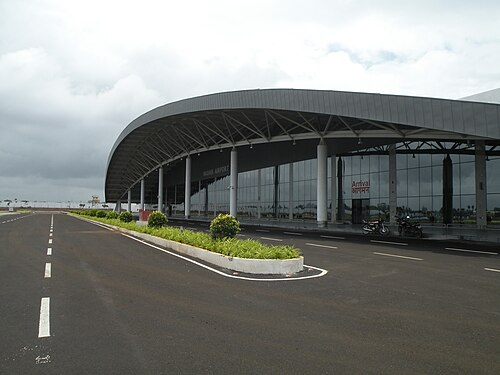
Today, Nashik Airport serves the Nashik Division and the broader North Maharashtra Region. It remains a base for the IAF and HAL and also handles widebody cargo services. Domestic passenger flights have increased since operations began, and international services are expected to start by late 2024, further improving air links for the district.
Ferries & Water Transport
Nashik’s historical transport network once relied on a series of ferries that operated on the Godavari River and its tributaries, serving local settlements and trade routes. According to the colonial district Gazetteer (1883), four main ferries played an important role in the 19th century. The principal ferry crossed the Godavari at Nashik, carrying passengers and goods across the river. Other ferries operated at Kokangaon over the Kadva, Chehedi across the Darna, and a newer route, introduced in 1880, linked Pandhurli and Bhagur. These ferries carried people, animals, and carts, providing essential local connections for markets and trade.
The ferry boats were usually built from teak and constructed to withstand seasonal floods. Many were built by a local Goanese craftsman and designed with double hulls for added stability. Crews were generally drawn from families with hereditary rights to ferry work. Ferry operations were regulated under the Ferry Act of 1868, with the rights to operate each crossing auctioned yearly. Fares were set to allow affordable transport for passengers and livestock.
Over time, the use of ferries declined as road connections improved and road transport became the main means of daily travel.
Traffic Map
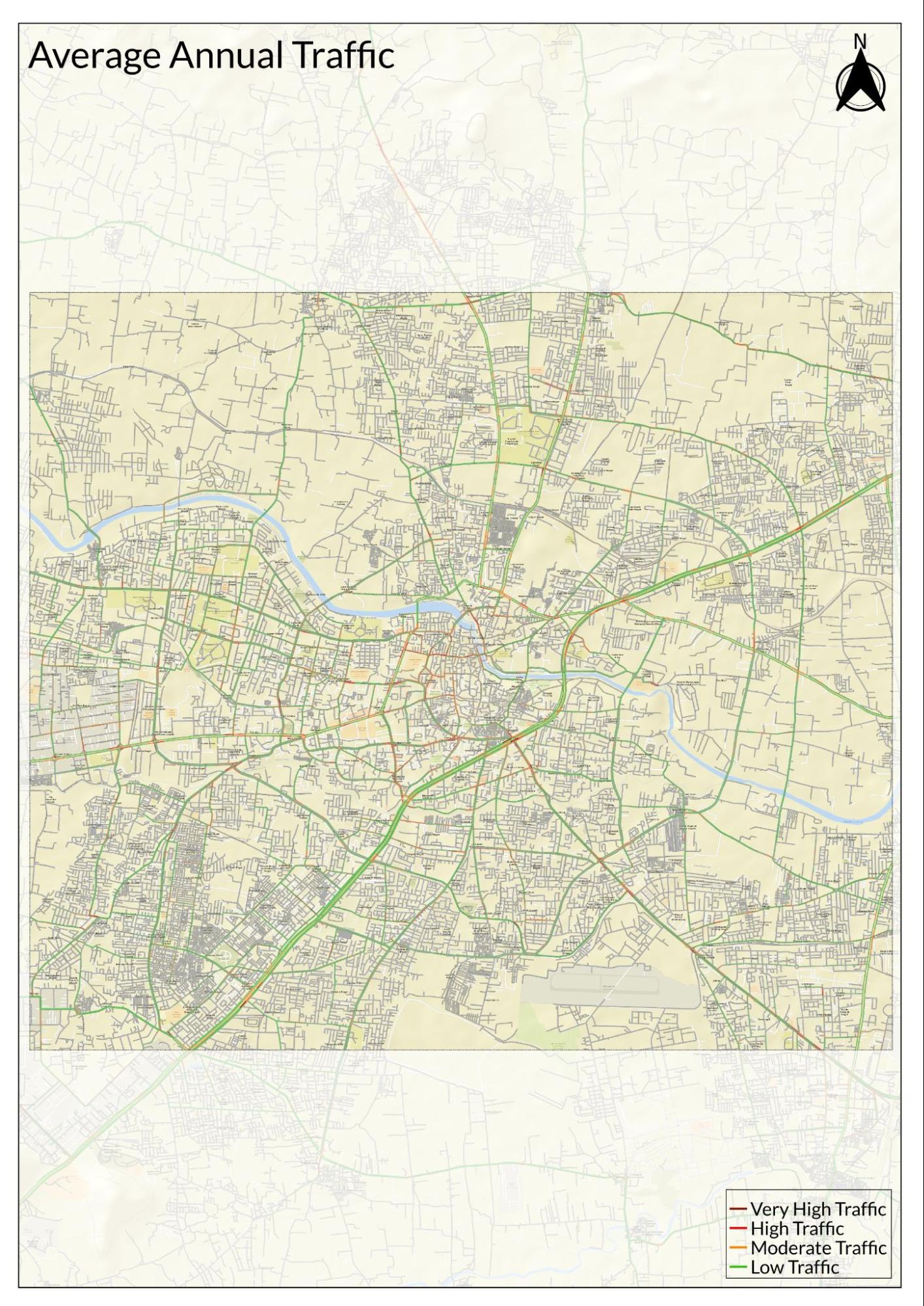
Communication Networks
Newspapers & Magazines
In the 20th century, Nashik developed as an important centre for newspaper publishing, contributing to the regional media landscape alongside other major cities such as Nagpur, Kolhapur, Satara, and Sangli. While larger cities often dominated Maharashtra’s print media, Nashik supported its own range of daily newspapers and periodicals.
Some notable publications, which are noted in the colonial district Gazetteer (1883), are the Nasik Vritta (Nasik News) and Ganga Lahari (Ganges’ Waves), two weekly Marathi papers published in Nashik town. Both were described to be modest single-sheet publications with limited circulation, each distributing fewer than 100 copies at the time. Notably, it is mentioned in the Gazetteer that other papers were started occasionally but often failed for lack of local support.
While some earlier publications have ceased, a range of regional, state, and national newspapers such as Lokmat, Sakal, Deshdoot, and The Times of India continue to circulate in Nashik today.

Graphs
Road Safety and Violations
Transport Infrastructure
Bus Transport
Communication and Media
Sources
Aditi Gupta. 2024. Explore Nashik's Pandavleni Caves Where Pandavas Lived. Outlook Traveller.https://www.outlooktraveller.com/experiences…
Aditi Shah. 2019. Nashik: Steeped in Legend & History. Peepul Tree.https://www.peepultree.world/livehistoryindi…
Deshdoot. 2021. 1889-1933: Remembering The Good Old Tram of Nashik. Deshdoot.https://deshdoot.com/1889-1933-remembering-t…
Government of Maharashtra. 1883 (reprinted in 1994). Gazetteers of the Bombay Presidency: Nasik District, Volume XVI. Gazetteer Department, Government of Maharashtra.
Nashik Web Portal. Citilinc: Nashik City Bus Services.https://citilinc.nmc.gov.in/#/
Poor Condition of Bus Termini Affecting Commuters in Nashik District. Times of India, Nashik.https://timesofindia.indiatimes.com/city/nas…
Pune Pulse. 2024. “Maharashtra: Nashik Airport to Launch International Flights Starting September 12.” Pune Pulse.https://www.mypunepulse.com/maharashtra-nash…
Times Property. 2024. “All About Nashik Airport.” Times Property.https://timesproperty.com/article/post/all-a…
Tushar Pawar. 2015. Nashik city bus service completes 4 years, sees surge in passengers & routes. Times of India.https://timesofindia.indiatimes.com/city/nas…
Tushar Pawar. 2023. Many Big Infra Projects For Nashik City Still On Paper. Times of India.https://timesofindia.indiatimes.com/city/nas…
Last updated on 6 November 2025. Help us improve the information on this page by clicking on suggest edits or writing to us.